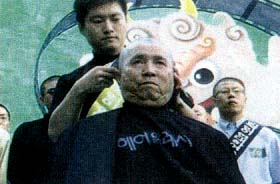
Shoot the Sun by Lyric: The Fight for the Screen Quota System in Korea
Cho Jai-Hong
Korea 1999
Produktion: Screen Quota Watchers, Seoul Visual Collective
Weltvertrieb: Seoul Visual Collective
5flr., 140-51 Kyedong, Chongro-gu, Seoul
Tel.: (82-2) 745 46 41, Fax: 361 24 990
E-mail: lookdocu@cholliian.net
Buch: Nam-Jim Lee
Kamera: Mario Lee, Young-Kyu Cho
Musik: Byeong-Jon Song
Ton: Sound & Compnay
Schnitt: Mario Lee, Dong-Soek Kim
Produzent: In-Gee Choi
Format: 35mm, 1:1.37, Farbe
Länge: 90 Minuten 24 Bilder/Sek.
Sprache: koreanisch
Arsenal 10.02., 12.00
CineStar 8 18.02., 11.00
CinemaxX 3 19.02., 15.30
Die 113 Mitglieder der Gruppe für den Schutz des koreanischen Films schnitten sich die Haare ab, um ihre tiefe Sorge über die Filmsituation des Landes zu bekunden. Von Juli 1998 an setzten sie über ein Jahr lang den verzweifelten Protest gegen die Abschaffung der Filmquote fort. Für sie geht es in dieser Auseinandersetzung nicht bloß um die Beibehaltung der Quote für koreanische Filme, sondern umfassender um die Bewahrung der kulturellen Identität Koreas gegen den kulturellen Imperialismus US-Amerikas, den Hollywood symbolisiert.
Der Dokumentarfilm berichtet von den Menschen, die sich an den Streikaktionen beteiligten. Wie in dem alten Mythos kämpfen sie als ‘Kulturheroen’ darum, die zweite Sonne mit ihrem Lied vom Himmel zu schießen.
An ancient history of Korea, tells the following myth: As a consequence
of the emergence of two suns in the sky, people were subjected to agony.
But when a monk named Wolmyong began to sing, one of the suns disappeared,
and peace returned to the region. The myth of the ‘sunshot’
is a common theme in northeast Asia. But while the heroes of other regions
shoot at the sun with arrows, our hero brings it down with a song. For
this reason, one scholar of Korean literature has called Wolmyong one
of the country’s cultural heroes.
113 members of a film industry initiative called the Emergency Committee
to Protect the Screen Quota System shaved their heads to express their
deep anger at government plans to reduce the number of days cinemas in
the country must show South Korean films. Their year-long protest was
not merely in support of keeping the quota as it was, but also in support
of maintaining South Korea’s cultural identity in the face of America’s
cultural imperialism, symbolised by Hollywood.
This documentary is a record of the efforts made by people trying to protect
South Korean film, and follows their struggle for a year. As in the ancient
myth, these modern-day cultural heroes attempt to shoot down the second
sun with their song.
Jai-Hong Cho, geb. 1960 in Seoul, Südkorea. Buchautor und Regisseur von Dokumentarfilmen, u.a.: The Camera Recording History (Taiwan, 1995), Hollywood in Asia (Hongkong 1996).